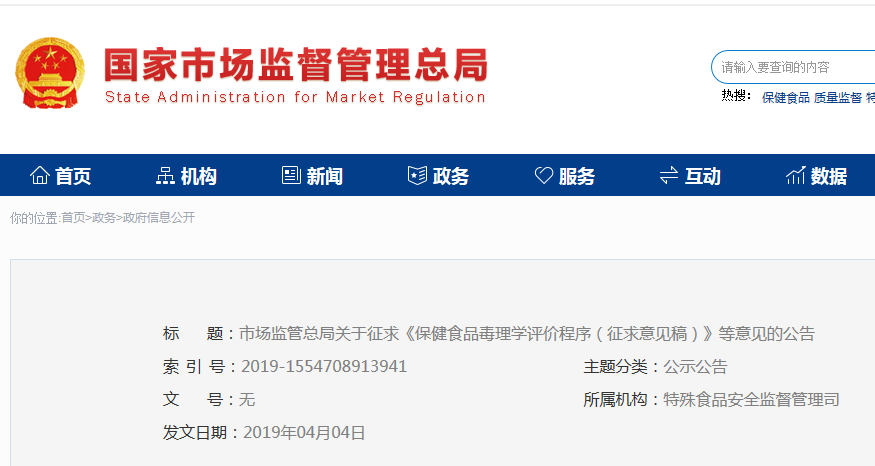
On April 8, 2019, the State Administration for Market Regulation (SAMR) issued “Toxicological Assessment Procedure of Health Food (Draft for public comments)” (hereinafter referred to as “the Draft”). CIRS made a comparative analysis between "the Draft" and "Technical Standards for Testing & Assessment of Health Food (Green Book) (2003 version)" from multiple aspects, including test items, test methods, etc.
Introduction
“Technical Standards for Testing & Assessment of Health Food (Green Book) (2003 version)” (hereinafter referred to as “the Green Book”) was abolished in July, 2018. After then, the test report in which the methods listed in the Green Book are used, cannot be used to apply for health food registration.
The contents of the Green Book include: assessment procedures and testing methods of 27 health functions, assessment procedures and testing methods of 18 health food toxicological tests, testing methods of 27 functional components and hygiene testing.
Currently, only the draft of toxicological assessment procedure was released for public comments. In terms of the assessment procedures and testing methods of health functions, the testing methods of functional components and hygiene testing which have been abolished, SAMR haven’t issued their draft for public comments.
Differences between the Draft and the Green Book
1. Sample for Toxicological Testing of Health Food
|
The Green Book |
The Draft |
|
Sample for toxicological testing should be health food product. |
Sample for toxicological testing should be health food product or raw material. |
PS. For the health food raw material which is required to conduct safety assessment, the assessment shall be conducted according to the regulations related to new food raw material, which is consistent with “Health Food Registration Review Rules” (hereinafter referred to as “the Review Rules”).
2. Main Items for Toxicological Testing of Health Food
|
The Green Book |
The Draft |
|
Generally, it is needed to conduct acute toxicity test, three genetic toxicity tests and 30-day feeding study. |
Generally, it is needed to conduct acute toxicity test, three genetic toxicity tests and 28-day oral toxicity test. |
3. Testing Methods for Toxicological Testing of Health Food
Generally, health food toxicological testing includes acute toxicity test, three genetic toxicity tests and 28-day oral toxicity test/30-day feeding study. CIRS made a comparative analysis for the above tests.
- Differences between 28-day oral toxicity test and 30-day feeding study:
4. Same Points
Some requirements listed in the Draft are consistent with the Green Book or GB 15193.1 “Toxicological Assessment Procedure for Food Safety”, detailed information are as follows:
- Toxicological design requirements for specific product, e.g., probiotic products
- Pretreatment of samples
- Judgment and application of tests result
- Factors that should be considered in safety comprehensive evaluation
5. Additional content listed in the Draft
The requirements for samples listed in the Draft are consistent with the Green Book and the Review Rules, “the animals function test and toxicological testing should use the same batch sample, which is one of the 3 batches samples used for the functional components or characteristic ingredients tests, hygiene test, stability test (except for the product which the shelf life is less than test period, e.g., probiotics, milk, etc.”. Meanwhile, the Draft supplements some additional information:
When the applicant is required to make a supplementary test, if the original batch samples which are used to apply for health registration have exceeded its shelf life, the supplementary test can use samples with new batch, however, applicant should provide all items test report based on technical requirements.
CIRS Comments:
Compared with the Green Book, the contents of the Draft are more detailed. Meanwhile, the Draft specifically indicated that health food is required to conduct toxicological tests based on GB 15193, and its test items are more than the Green Book.
The biggest difference between the Draft and the Green Book: toxicological tests is required to conduct 30-day feeding study according to the Green Book, however, the Draft requires to conduct 28-day oral toxicity test. And the Draft is in consistent with the Review Rules, but the 30-day feeding study required by the Green Book is contradictory with the Review Rules before it was abolished. Except for above information, there is no additional change for the Draft.
If you have any needs or questions, please contact us at service@hfoushi.com.
Reference:
Official News

